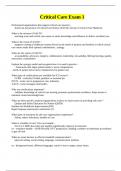Critical Care Exam 1
Professional organizations that support critical care practice -
American Association of Critical Care Nurses (AACN), Society of Critical Care Medicine
What is the mission of AACN? -
assisting acute and critical care nurses to attain knowledge and influence to deliver excellent care
What is the vision of AACN? -
supports creating a healthcare system driven by the needs of patients and families in which critical
care nurses make their optimal contributions...synergy
What are the values of AACN? -
accountability, advocacy, integrity, collaboration, leadership, stewardship, lifelong learning, quality,
innovation, commitment
Explain the synergy model and recognize how it is used in practice -
- framework that aligns patient needs w nurse competencies
- needs of patient drive nurse competencies for patient care
What types of certifications are available for ICU nurses? -
CCRN - critically ill adult, pediatric or neonatal pts
PCCN - acute care in progressive care, telemetry
AACN - nurse managers and leaders
Why are certifications important? -
validates knowledge of critical care nursing, promotes professional excellence, helps nurses to
maintain current knowledge base
What are three specific projects/organizations in place to assist nurses in providing safe care? -
Quality and Safety Education for Nurses (QSEN)
Institute for Healthcare Improvement (IHI)
Rapid response teams/joint commission (?)
What types of measures do safe care organizations implement? -
Safety, reduce infections, bundles of care
What is a bundle of care? Give an example. -
Set of 3-5 EBPs that when put together significantly improve pt outcomes
ex - ventilator bundle -- HOB elevated, DVT prophylaxis, holding a sedative to determine pt readiness
to get off vent
What are some barriers to effective handoff communication? -
physical setting, social setting, language, communication medium
ex - background noise, different languages, email vs text vs paper, status issues
, What standardized measures have been implemented to help prevent communication breakdown at
shift change? -
SBAR, checklists
What are examples of things you may need to communicate during multi-professional rounds? -
D/C needs, greatest safety risk, assessment and followup, implementation of bundles, assess need
for all ordered meds, identify whether central lines & catheters can be removed, code status, family
needs, advance directives, when to call MD, tx goals
What types of things contribute to sensory overload/deprivation in a critical care environment? -
noise level, environment different than surroundings causing hallucinations, lighting
What types of interventions can nurses implement to combat sensory overload/deprivation? -
Noise: place pt in private room, soundproof ceiling tiles, sedative music, quickly assess alarms
Hallucinations: post family photos, encourage visitation, interact w pt
Use natural lighting
help design optimal and safe environment
What types of stressors do patients identify from their critical care experience? -
difficulty communicating, pain, thirst, difficulty swallowing, anxiety, lack of control,
depression/fear, lack of family/friends, physical restraint, feelings of dread, inability to get comfortable,
difficulty sleeping, loneliness, thoughts of death
What age-related demographic is at high risk for negative outcomes in the ICU? -
older adults >65 yo
What types of situations contribute to family conflict being present? -
feelings/concerns of family; unresolved family issues
How can nurses best support the family members of patients and assist them in coping? -
evaluate, plan, involve, communicate, support
family-centered interventions
see if family can help w care so they feel more in control
What is the main cause of emotional outbreak or inappropriate responses from family members? -
lack of communication
What does research say about family visitation in the ICU? -
results in better patient outcomes, liberal visitation is encouraged
What are the benefits to allowing family presence during codes? -
promotes increased knowledge of pt condition/removes doubts
witness everything possible was done
decrease anxiety and fear about what is happening to their loved one
sense of closure
autonomy -




